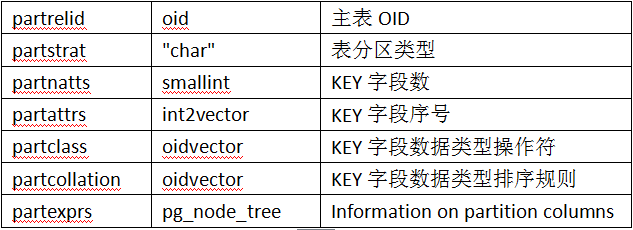PostgreSQL V10 分割槽表特性
目錄
環境
系統平臺:N/A
版本:10.3
詳細資訊
分割槽表特性是PG10新加的一個很重要的特性。
之前的版本也能實現分割槽表功能,是根據“繼承表+約束+規則或觸發器”實現。
相對於之前的分割槽實現方式,PG10的分割槽特性有以下優勢:
1)管理分割槽方便
2)資料插入效率高
事實上,PG10的分割槽特性也是在內建繼承表的基礎上實現的,所以建立的分割槽實質上也是普通的表結構。
目前PG10支援範圍分割槽和列表分割槽,雜湊分割槽還不支援。
範圍分割槽:
PG10的分割槽表在建表語法上,主表和分割槽是單獨建立的。下面的列表分割槽也是一樣。
建立主表語法:
CREATE TABLE 表名 ( [{ 列名稱 資料_型別} [, ... ] ] )
PARTITION BY RANGE ( [{ 列名稱 } [, ...] ] );
範圍分割槽的KEY值可由多個欄位組成(最多32個欄位)。
建立分割槽語法:
CREATE TABLE 表名 PARTITION OF 主表 FOR VALUES
FROM{ ( 表示式 [, ...] ) | MINVALUE } [, ...]
TO { ( 表示式 [, ...] ) | MAXVALUE } [, ...] [ TABLESPACE 表空間名 ];
引數說明:
// FROM ... TO 表示分割槽的起始值和結束值。
// MINVALUE / MAXVALUE 表示無限小值和無限大值。
// 預設FROM後面的值是包括值分割槽的約束內,TO後面的值不包括。
示例:
| postgres=# create table test(n int) partition by range(n); CREATE TABLE postgres=# create table test_1 partition of test for values from (MINVALUE) to (10); CREATE TABLE postgres=# create table test_2 partition of test for values from (10) to (100); CREATE TABLE postgres=# create table test_3 partition of test for values from (100) to (1000); CREATE TABLE postgres=# create table test_4 partition of test for values from (1000) to (10000); CREATE TABLE
postgres=# \d+ test Table "public.test" Column | Type | Collation | Nullable | Default | Storage | Stats target | Descrip tion --------+---------+-----------+----------+---------+---------+--------------+-------- ----- n | integer | | | | plain | | Partition key: RANGE (n) Partitions: test_1 FOR VALUES FROM (MINVALUE) TO (10), test_2 FOR VALUES FROM (10) TO (100), test_3 FOR VALUES FROM (100) TO (1000), test_4 FOR VALUES FROM (1000) TO (10000)
postgres=# \d+ test_2 Table "public.test_2" Column | Type | Collation | Nullable | Default | Storage | Stats target | Descrip tion --------+---------+-----------+----------+---------+---------+--------------+-------- ----- n | integer | | | | plain | | Partition of: test FOR VALUES FROM (10) TO (100) Partition constraint: ((n IS NOT NULL) AND (n >= 10) AND (n < 100))
postgres=# insert into test select generate_series(0, 9999);INSERT 0 10000 postgres=# explain analyze select * from test;
QUERY PLAN
------------------------------------------------------------------------------------- -------------------------- Append (cost=0.00..248.50 rows=17850 width=4) (actual time=0.010..11.248 rows=10000 loops=1) -> Seq Scan on test_1 (cost=0.00..35.50 rows=2550 width=4) (actual time=0.009..0 .014 rows=10 loops=1) -> Seq Scan on test_2 (cost=0.00..35.50 rows=2550 width=4) (actual time=0.012..0 .044 rows=90 loops=1) -> Seq Scan on test_3 (cost=0.00..35.50 rows=2550 width=4) (actual time=0.025..0 .441 rows=900 loops=1) -> Seq Scan on test_4 (cost=0.00..142.00 rows=10200 width=4) (actual time=0.026. .4.317 rows=9000 loops=1) Planning time: 0.248 ms Execution time: 14.503 ms (7 rows) |
列表分割槽:
列表的KEY只支援一個欄位。
建立主表語法:
CREATE TABLE 表名 ( [{ 列名稱 資料_型別} [, ... ] ] )
PARTITION BY LIST( { 列名稱 } );
建立分割槽語法:
CREATE TABLE 表名 PARTITION OF 主表 FOR VALUES
IN ( 表示式 [, ...] ) [ TABLESPACE 表空間名 ];
示例:
| postgres=# CREATE TABLE sales (product_id int, saleroom int, province text) PARTITION BY LIST(province); CREATE TABLE postgres=# CREATE TABLE sales_east PARTITION OF sales FOR VALUES IN ('山東','江蘇',' 上海'); CREATE TABLE postgres=# CREATE TABLE sales_west PARTITION OF sales FOR VALUES IN ('山西','陝西',' 四川'); CREATE TABLE postgres=# CREATE TABLE sales_north PARTITION OF sales FOR VALUES IN ('北京','河北','遼寧'); CREATE TABLE postgres=# CREATE TABLE sales_south PARTITION OF sales FOR VALUES IN ('廣東','福建');CREATE TABLE
postgres=# \d+ sales Table "public.sales" Column | Type | Collation | Nullable | Default | Storage | Stats target | De scription ------------+---------+-----------+----------+---------+----------+--------------+--- ---------- product_id | integer | | | | plain | | saleroom | integer | | | | plain | | province | text | | | | extended | | Partition key: LIST (province) Partitions: sales_east FOR VALUES IN ('山東', '江蘇', '上海'), sales_north FOR VALUES IN ('北京', '河北', '遼寧'), sales_south FOR VALUES IN ('廣東', '福建'), sales_west FOR VALUES IN ('山西', '陝西', '四川')
postgres=# \d+ sales_east Table "public.sales_east" Column | Type | Collation | Nullable | Default | Storage | Stats target | De scription ------------+---------+-----------+----------+---------+----------+--------------+--- ---------- product_id | integer | | | | plain | | saleroom | integer | | | | plain | | province | text | | | | extended | | Partition of: sales FOR VALUES IN ('山東', '江蘇', '上海') Partition constraint: ((province IS NOT NULL) AND (province = ANY (ARRAY['山東'::text , '江蘇'::text, '上海'::text])))
postgres=# insert into sales values (1001, 2345234, '山東'); INSERT 0 1 postgres=# insert into sales values (1002, 23233, '河北'); INSERT 0 1 postgres=# insert into sales values (1001, 4357233, '廣東'); INSERT 0 1 postgres=# insert into sales values (1002, 67233, '陝西'); INSERT 0 1
postgres=# explain analyze select * from sales;
QUERY PLAN
------------------------------------------------------------------------------------- --------------------------- Append (cost=0.00..88.00 rows=4800 width=40) (actual time=0.009..0.023 rows=4 loops =1) -> Seq Scan on sales_east (cost=0.00..22.00 rows=1200 width=40) (actual time=0.0 08..0.009 rows=1 loops=1) -> Seq Scan on sales_west (cost=0.00..22.00 rows=1200 width=40) (actual time=0.0 03..0.003 rows=1 loops=1) -> Seq Scan on sales_north (cost=0.00..22.00 rows=1200 width=40) (actual time=0. 003..0.003 rows=1 loops=1) -> Seq Scan on sales_south (cost=0.00..22.00 rows=1200 width=40) (actual time=0. 002..0.003 rows=1 loops=1) Planning time: 0.305 ms Execution time: 0.054 ms (7 rows) |
獲取系統資訊(系統表):
pg_partitioned_table 記錄主表資訊的系統表:

分割槽的資訊記錄在pg_class相關的欄位中:

獲取系統資訊(分割槽函式):
| pg_get_partkeydef (Oid relid) -- 根據主表OID返回分割槽型別及KEY: postgres=# select pg_get_partkeydef('test'::regclass); pg_get_partkeydef ------------------- RANGE (n) (1 row)
pg_get_partition_constraintdef (Oid relid) -- 根據分割槽OID獲取分割槽約束條件: postgres=# select pg_get_partition_constraintdef('test_1'::regclass); pg_get_partition_constraintdef -------------------------------- ((n IS NOT NULL) AND (n < 10)) (1 row) |
其他操作—ATTACH操作:
ATTACH操作是把和主表有相同表結構的主表變成該主表的一個分割槽:
範圍分割槽:
ALTER TABLE 主表名 ATTACH PARTITION 表名 FOR VALUES
FROM{ ( 表示式 [, ...] ) | MINVALUE } [, ...]
TO { ( 表示式 [, ...] ) | MAXVALUE } [, ...];
列表分割槽:
ALTER TABLE 主表名 ATTACH PARTITION 表名 FOR VALUES
IN ( 表示式 [, ...] );
更多示例請登入【瀚高技術支援平臺】檢視
https://support.highgo.com/#/index/docContent/a1b0eba8026447db
